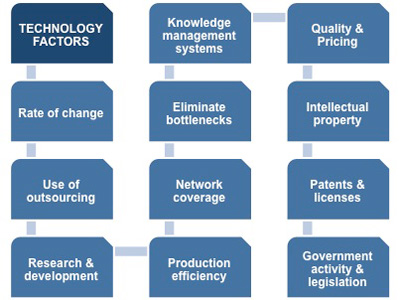Technological Factors

 |
This element has become a key factor for organizations in assessing and listing issues that could have a potential impact on its operations and that could be critical to its long-term future. The pace of change in technology is becoming more rapid, and often changes that impact your market come from unexpected sources.
For example, could the film industry ten years ago have predicted that people would stream their new releases rather than go to the cinema or buy a DVD?
It is by using such techniques as PESTLE that organizations will be able to brainstorm even the most bizarre suggestions, because what today seems impossible may become commonplace in just a few years.
Technological factors can be broadly divided into two areas: manufacture and infrastructure. By exploiting opportunities to update or alter their production an organization can gain market share, thereby attaining a strong competitive advantage. Such activities include:
• Automation
• Improved quality of parts and end product
• Incentives
• Significant cost savings
• Use of outsourcing to control costs and offer greater flexibility
Technological advances have also allowed organizations much greater freedom of choice when deciding how best to manage their operations. For example, knowledge-based systems have enabled management to make better and more informed decisions in real-time.
The rapid growth in networking capabilities, both in terms of being more reliable and having extensive coverage internationally, has allowed organizations to streamline their workflow and eliminate operational bottlenecks.
Organizations that fail to keep up with technological advances leave opportunities for a smaller producer or new entrant to enter their market and erode their leadership status.
This is what happened to mobile phone producers Research in Motion (RIM, the makers of the BlackBerry) and Nokia, who were slow to embrace smartphone technologies. The result was that they both lost significant market share to Apple and Samsung.
This example clearly illustrates how consumers' preferences and usage change following a technological advance and how this feeds through to market share. Many organizations want to protect their advantage as long as possible, so the use of patents and licensing has become a key strategy for many in protecting their intellectual property.
The impact of technology on the individual has led to legislation being introduced which aims to protect your privacy and ensure organizations have to gain your permission before emailing or contacting you. Organizations need to give careful thought to the type and nature of potential legislation that governments could introduce to curb what is often seen as the invasive side of the rapid growth of technology.
You may also be interested in: Introduction to PESTLE Analysis, PESTLE Factors, Political Factors, Economic Factors, Social Factors, Technological Factors, Legal Factors, Environmental Factors and Advantages and Disadvantages.



